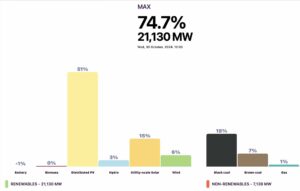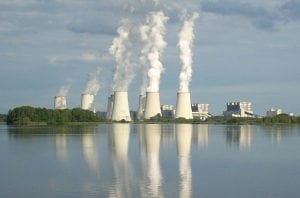A recent Hollywood film portrayed humanity’s disinterest in “looking up” at an approaching “planet killing” comet. That film was an allegory for how, decades after the initial warnings, we’ve failed to ensure a safe climate for our children, or even for ourselves.
But here in Australia, as in other fossil-fuel endowed nations, we don’t even have to “look up” to see governments and businesses enthusiastically supporting an endless list of new planet-killing fossil-fuel projects.
We only need to look around, because there are new planet-killers lined up in nearly every state and territory.
Millions of Australians are taking “personal responsibility” and trying to reduce their climate impacts. However, any one of these government-sponsored planet-killers, with their giga-tonnes of greenhouse gas emissions often potentially adding up to many times Australia’s current annual emissions, will wipe out the sum of our personal achievements faster than a flaming meteor.
In this article, let’s tour around Australia visiting just some of the planet killers that have recently been in the news. Let’s start in Australia’s driest state: South Australia.
South Australia – disaster waits in the desert
South Australia is often held as that international paragon of renewable-energy virtue. For making electricity, wind and solar have supplanted SA’s economically-depleted reserves of coal and gas, achieving “100% renewable electricity” on many days. Isn’t it wonderful!
But all is not clean and green in SA. Just because coal in that state can no longer be economically exploited with conventional technologies, this hasn’t stopped the state government there from supporting a ghastly, discredited technology known as underground coal gasification (UCG).
UCG has already been banned in Queensland, a state not known for its scrutiny of mining proposals. But what is it?
UCG more or less involves dropping a burning torch down into a coal seam and then seeing if some useful gas comes out where it is supposed to come out. If, on the other hand, fuming gas leaks out somewhere else, or aquifers become polluted, or the coal continues to burn unstoppably underground, what happens then? It seems best practice in this industry is to pack up and promise jobs in another jurisdiction where this pyrotechnic abomination hasn’t yet been banned.
Sadly, around the world coal seams already burn out of control and cannot be extinguished. South Australia’s gift to our dying Earth might yet be a greenhouse-gas spewing, planet-killing underground inferno hidden away under the scenic desert sands.
Victoria – “the place to be” chasing coal and gas
Victoria has a long history of relying on “1,000 years” worth of brown coal and those “world-class” oil and gas deposits out in the Bass Strait.
But even as the state energy minister celebrates how Victoria hasn’t been quite as lethargic as New South Wales and Queensland in promoting large-scale wind and solar, there is still a longing not to let all of that fabulous brown coal go to waste, and also to dream that another Bass Strait might yet be found.
Fantastic plans (as in “fantasy – the activity of imagining impossible things”) are being pursued to turn those huge coal deposits into hydrogen, with the just-as-huge byproduct greenhouse gases made to simply disappear.
Rather it is the Victorian coastline that is disappearing beneath the rising sea. Next time you are at the beach, take time to “look-up” at the oil and gas drilling rigs operating offshore in state and federal waters. The only emergency action in Victoria seems to be the speed at which new oil and gas drilling approvals are granted.
New South Wales – has coal, wants gas
New South Wales is home to the world’s largest coal shipping port. But given that Sydney suburbs are being washed out to sea, clearly this Number One planet-killing position needs a public-relations makeover. So here is some happier news. No later than 2040 maybe, the energy used to drive all those conveyor belts dumping all that coal into all those ships will be renewable!
Marvellous? Or marvellously cynical?
And where does all that record-setting coal come from, and how long will we keep doing this? Even as New South Wales’ coal-mining regions disappear under flood waters, there is no end in sight for new coal mine and expansion proposals, planet-killers each, lined up like the coal ships out in Newcastle harbour.
If maintaining a lead in fossil-coal exports was not enough, NSW now wants to get into the fossil-gas game. This means pin-cushioning a thousand coal seam gas wells into the fresh water aquifers of the Great Artesian Basin under the Pillaga State Forest near Narrabri, which is just collateral damage in this planet-killing boardroom game.

Queensland – beautiful one day, fracked bleached and flooded the next
Though Newcastle may be Australia’s largest coal port, Queensland, when it isn’t flooded out, produces more coal than the rest of Australia combined.
The famed “Adani” mine was just one added to Queensland’s planet-killing capacity. In their “Major Project Pipeline” report, the Queensland government lists 25 new coal mine projects or expansions.
Where there is coal, there must be gas! Since 2015 and the drilling of tens of thousands of coal seam gas wells, Queensland now exports three times more gas (in the form of “liquefied natural gas” or LNG) than is burned across the rest of eastern Australia.
But why stop there? In the search for oil and gas, why not frack everything from Mackay to Lake Eyre? As the climate-wrecking methane released during oil and gas production rises into the air, with all the wells we’ll be drilling across Australia, there’ll be no time for “looking up”.
Northern Territory – frack the outback and what lies… offshore
The rising heat in the Northern Territory may see it lose its doctors, but at least it’s set to be home to a couple more planet killers that we’ll call B1 and B2: Barossa and Beetaloo.
The proponents of B1, the offshore Barossa project, tried to convince us that their fossil gas was carbon dioxide free. But like unicorns or jobs on a comet, there isn’t any such thing. Rather, Barossa is a waste-carbon-dioxide-emissions plant masquerading as a gas-export plant. As reported by the ABC, “normally, [when] you set out to manufacture something, you try to minimise waste. Unfortunately, in this case, there is going to be more waste than product.”
When the NT government approved B2, the shale fracking project Beetaloo, they thought it was fantastic (that word again). They imagined the impossible thing that all the greenhouse gas emissions that Beetaloo would ever produce in Australia and overseas would somehow be offset. For example, someone somewhere somehow would have to plant a heap of trees.
A few years later when the impossibility of that fantasy became obvious, a new category of “indirect offsets” was established, allowing the oil and gas companies to think about offsetting something, rather than being required to actually ever offset anything. Fun fact: you can’t offset a planet killer.
Western Australia – hermit kingdom captivated by oil and gas
In Western Australia, temperatures recently hit a record 50 deg C. But what is really hot out west is the pace at which oil and gas projects are approved. Has WA become the hermit kingdom captivated by oil and gas?
WA has been a massive exporter of liquefied gas for decades. But don’t look up because government and business leaders there tell us that we haven’t seen anything yet.
Even though “world-class” global operators such as Shell struggle to keep the complex gas operations they have already built safely running, Chevron can’t work out how to reliably pump carbon dioxide into the ground, and royalties and taxes go uncollected as Australian resources are essentially given away, other fossil fuel companies line up and ask to repeat these efforts. And the WA government happily say yes.
And lest any fossil fuel dare remain in the ground, fracking the Kimberley is the latest Texan’s oily dream. Given the bad health impacts of fracking, I suppose the approving authorities will hope there aren’t many pregnant women living in the Kimberley.
After all, what are oil and gas companies to do other than produce oil and gas, dabble in solar panels?
I don’t want to look up… at all this
As I thought might happen, writing this article has been difficult and filled me with sadness. I’ve been active in the climate horrors and solutions space for 15 years. But like the people in the Hollywood film, recently I haven’t wanted to “look up” at this seemingly endless stream of new Australian planet-killing proposals that show no sign of stopping. Looking up sickens me. Looking up especially sickens me after I’ve been looking down at the smiling faces of my grandchildren.
Nevertheless, nearing the end here I feel the need to add one of those “what YOU can do” suggestions. But what can be done? What haven’t we tried already?
Your vote and support
Federal and state elections loom. Get involved and strongly support candidates who have declared real climate action as a top priority. These will either be independents or candidates not linked to the incumbent parties that have failed us for so long. If it’s our planet’s last chance, then it’s probably our democracy’s last chance too.
Tim Forcey is an independent energy researcher and commentator.










